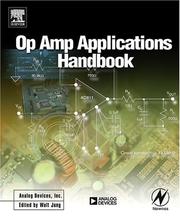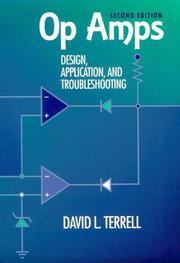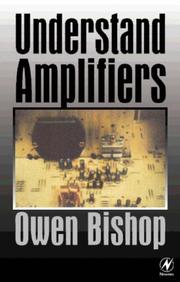| Listing 1 - 10 of 17 | << page >> |
Sort by
|
Book
ISBN: 3030707296 3030707288 Year: 2021 Publisher: Cham, Switzerland : Springer,
Abstract | Keywords | Export | Availability | Bookmark
 Loading...
Loading...Choose an application
- Reference Manager
- EndNote
- RefWorks (Direct export to RefWorks)
Amplifiers (Electronics) --- Amps (Electronics) --- Electronic amplifiers --- Radio amplifiers --- Electronics

ISBN: 1281020176 9781417552727 9786611020170 0080491995 0750678445 1417552727 9781417552726 9781281020178 Year: 2005 Publisher: Amsterdam Boston Newnes
Abstract | Keywords | Export | Availability | Bookmark
 Loading...
Loading...Choose an application
- Reference Manager
- EndNote
- RefWorks (Direct export to RefWorks)
Operational amplifiers play a vital role in modern electronics design. The latest op amps have powerful new features, making them more suitable for use in many products requiring weak signal amplification, such as medical devices, communications technology, optical networks, and sensor interfacing. The Op Amp Applications Handbook may well be the ultimate op amp reference book available. This book is brimming with up-to-date application circuits, valuable design tips, and in-depth coverage of the latest techniques to simplify op amp circuit designs, and improve their performance. As an
Operational amplifiers --- Amplifiers (Electronics) --- Amps (Electronics) --- Electronic amplifiers --- Radio amplifiers --- Electronics
Book
ISBN: 1282737805 9786612737800 0080949487 1856175057 Year: 2009 Publisher: Amsterdam ; Boston : Elsevier, Newnes,
Abstract | Keywords | Export | Availability | Bookmark
 Loading...
Loading...Choose an application
- Reference Manager
- EndNote
- RefWorks (Direct export to RefWorks)
The op amp IC has become the universal analog IC because it can perform all analog tasks. OP AMPS FOR EVERYONE provides the theoretical tools and practical know-how to get the most from these versatile devices. This new edition substantially updates coverage for low-speed and high-speed applications, and provides step by step walkthroughs for design and selection of op amps and circuits.* Modular organization allows readers, based on their own background and level of experience, to start at any chapter* written by experts at Texas Instruments and based on real op amps and circuit
Operational amplifiers. --- Amplifiers (Electronics) --- Amps (Electronics) --- Electronic amplifiers --- Radio amplifiers --- Electronics
Book
ISBN: 1280642726 9786610642724 0080462960 9780080462967 9780750681667 Year: 2006 Publisher: Oxford Burlington, MA Newnes
Abstract | Keywords | Export | Availability | Bookmark
 Loading...
Loading...Choose an application
- Reference Manager
- EndNote
- RefWorks (Direct export to RefWorks)
Whether you are a dedicated audiophile who wants to gain a more complete understanding of the design issues behind a truly great amp, or a professional electronic designer seeking to learn more about the art of amplifier design, there can be no better place to start than with the 35 classic magazine articles collected together in this book.Douglas Self offers a tried and tested method for designing audio amplifiers in a way that improves performance at every point in the circuit where distortion can creep in - without significantly increasing cost. Through the articles in this book, he
Audio amplifiers --- Amplifiers (Electronics) --- Amps (Electronics) --- Electronic amplifiers --- Radio amplifiers --- Electronics --- Amplifiers, Audio --- Audio-frequency amplifiers --- Design and construction.

ISBN: 1281077615 9786611077617 0080513085 058547074X 0750697024 9780750697026 9780585470740 9780080513089 9781281077615 6611077618 Year: 1996 Publisher: Boston Butterworth-Heinemann
Abstract | Keywords | Export | Availability | Bookmark
 Loading...
Loading...Choose an application
- Reference Manager
- EndNote
- RefWorks (Direct export to RefWorks)
OP Amps deliberately straddles that imaginary line between the technician and engineering worlds. Topics are carefully addressed on three levels: operational overview, numerical analysis, and design procedures. Troubleshooting techniques are presented that rely on the application of fundamental electronics principles. Systematic methods are shown that can be used to diagnose defects in many kinds of circuits that employ operational amplifiers.One of the book's greatest strengths is the easy-to-read conversational writing style. The author speaks directly to the student in a manner

ISBN: 1281021644 9786611021641 0080519881 0750637439 9780750637435 9780080519883 Year: 1998 Publisher: Oxford [England] Boston Newnes
Abstract | Keywords | Export | Availability | Bookmark
 Loading...
Loading...Choose an application
- Reference Manager
- EndNote
- RefWorks (Direct export to RefWorks)
This is a readable introduction for those with little previous knowledge of the subject. The theme of amplification is central to many branches of electronics. Consequently there is a large and confusing array of amplifier types intended for a wide range of applications. This book describes amplifier types, how they work, their properties, advantages and disadvantages, and applications. Amplifiers are treated with the minimum of mathematics and lots of illustrations.Owen Bishop is a prolific author of books for those interested in electronics, including experimenters, students and prac
Amplifiers (Electronics). --- Electrical Engineering --- Electrical & Computer Engineering --- Engineering & Applied Sciences --- Amplifiers (Electronics) --- Electronics. --- Amps (Electronics) --- Electronic amplifiers --- Radio amplifiers --- Electrical engineering --- Physical sciences --- Electronics
Book
ISBN: 008096639X 0080966381 1306119995 9780080966397 9780080966380 Year: 2014 Publisher: London : Newnes,
Abstract | Keywords | Export | Availability | Bookmark
 Loading...
Loading...Choose an application
- Reference Manager
- EndNote
- RefWorks (Direct export to RefWorks)
Building Valve Amplifiers is a unique hands-on guide for anyone working with tube audio equipment--as an electronics hobbyist, audiophile or audio engineer. This 2nd Edition builds on the success of the first with technology and technique revisions throughout and, significantly, a major new self-build project, worked through step-by-step, which puts into practice the principles and techniques introduced throughout the book. Particular attention has been paid to answering questions commonly asked by newcomers to the world of the valve, whether audio enthusiasts tackling the
Audio amplifiers. --- Amplifiers (Electronics) --- Amps (Electronics) --- Electronic amplifiers --- Radio amplifiers --- Electronics --- Amplifiers, Audio --- Audio-frequency amplifiers --- Audio amplifiers --- Design and construction. --- Maintenance and repair.
Book
ISBN: 1281768049 9786611768041 1934404144 9781934404140 9781934404133 1934404136 9781281768049 6611768041 Year: 2008 Publisher: [Fremont, Calif.] Orchard Pub.
Abstract | Keywords | Export | Availability | Bookmark
 Loading...
Loading...Choose an application
- Reference Manager
- EndNote
- RefWorks (Direct export to RefWorks)
This is an introductory text containing the description and applications of state-of-the-art solid=state electronic devices. It includes many practical examples to illustrate their use.
Amplifiers (Electronics) --- Electronic apparatus and appliances. --- Electronic devices --- Electronics --- Physical instruments --- Scientific apparatus and instruments --- Electronic instruments --- Amps (Electronics) --- Electronic amplifiers --- Radio amplifiers --- Apparatus and appliances
Book
ISBN: 1283550008 9786613862457 1934404268 9781934404263 9781934404256 193440425X Year: 2012 Publisher: [Fremont, CA] : Orchard Publications,
Abstract | Keywords | Export | Availability | Bookmark
 Loading...
Loading...Choose an application
- Reference Manager
- EndNote
- RefWorks (Direct export to RefWorks)
Electronic apparatus and appliances. --- Amplifiers (Electronics) --- Electronic devices --- Electronics --- Physical instruments --- Scientific apparatus and instruments --- Electronic instruments --- Amps (Electronics) --- Electronic amplifiers --- Radio amplifiers --- Apparatus and appliances --- MATLAB. --- MATLAB (Computer program) --- MATLAB (Computer file) --- Matrix laboratory
Book
ISBN: 0306487322 Year: 2003 Publisher: Boston : Kluwer Academic Publishers,
Abstract | Keywords | Export | Availability | Bookmark
 Loading...
Loading...Choose an application
- Reference Manager
- EndNote
- RefWorks (Direct export to RefWorks)
Analog design is one of the more difficult aspects of electrical engineering. The main reason is the apparently vague decisions an experienced designer makes in optimizing his circuit. To enable fresh designers, like students electrical engineering, to become acquainted with analog circuit design, structuring the analog design process is of utmost importance. Structured Electronic Design: Negative-Feedback Amplifiers presents a design methodology for negative-feedback amplifiers. The design methodology enables to synthesize a topology and to, at the same time, optimize the performance of that topology. Key issues in the design methodology are orthogonalization, hierarchy and simple models. Orthogonalization enables the separate optimization of the three fundamental quality aspects: noise, distortion and bandwidth. Hierarchy ensures that the right decisions are made at the correct level of abstraction. The use of simple models, results in simple calculations yielding maximum-performance indicators that can be used to reject wrong circuits relatively fast. The presented design methodology divides the design of negative-feedback amplifiers in six independent steps. In the first two steps, the feedback network is designed. During those design steps, the active part is assumed to be a nullor, i.e. the performance with respect to noise, distortion and bandwidth is still ideal. In the subsequent four steps, an implementation for the active part is synthesized. During those four steps the topology of the active part is synthesized such that optimum performance is obtained. Firstly, the input stage is designed with respect to noise performance. Secondly, the output stage is designed with respect to clipping distortion. Thirdly, the bandwidth performance is designed, which may require the addition of an additional amplifying stage. Finally, the biasing circuitry for biasing the amplifying stages is designed. By dividing the design in independent design steps, the total global optimization is reduced to several local optimizations. By the specific sequence of the design steps, it is assured that the local optimizations yield a circuit that is close to the global optimum. On top of that, because of the separate dedicated optimizations, the resource use, like power, is tracked clearly. Structured Electronic Design: Negative-Feedback Amplifiers presents in two chapters the background and an overview of the design methodology. Whereafter, in six chapters the separate design steps are treated with great detail. Each chapter comprises several exercises. An additional chapter is dedicated to how to design current sources and voltage source, which are required for the biasing. The final chapter in the book is dedicated to a thoroughly described design example, showing clearly the benefits of the design methodology. In short, this book is valuable for M.Sc.-curriculum Electrical Engineering students, and of course, for researchers and designers who want to structure their knowledge about analog design further.
Engineering. --- Computer-aided engineering. --- Electrical engineering. --- Electronic circuits. --- Circuits and Systems. --- Electrical Engineering. --- Computer-Aided Engineering (CAD, CAE) and Design. --- CAE --- Engineering --- Electric engineering --- Electron-tube circuits --- Electric circuits --- Electron tubes --- Electronics --- Data processing --- Feedback amplifiers --- Amplifiers (Electronics) --- Design and construction. --- Amps (Electronics) --- Electronic amplifiers --- Radio amplifiers
| Listing 1 - 10 of 17 | << page >> |
Sort by
|

 Search
Search Feedback
Feedback About UniCat
About UniCat  Help
Help News
News